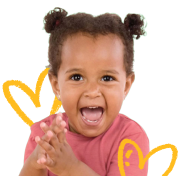
You’ve worked on the signs for months, but still baby isn’t signing back. You notice those little eyes looking intently at your hand signing milk, but the most response you are getting is an open mouth ready for the next bite. Sound familiar? Don’t be discouraged! Though you may feel like a BSL teaching failure, chances are good that she is understanding the signs long before she has the fine motor skills to mimic them.
Your can help develop those motor skills and encourage her signing through modeling. Teaching baby sign language through modeling involves shaping your little one’s hands in order to help them make the sign while you repeat the sign’s meaning and offer context such as giving a bottle of milk after you help baby open and close a fist (the sign for milk).
To get the most out of model teaching, consider changing your perspective. Position yourself behind baby; teaching with baby in your lap, for example. This sounds odd, but it will feel more natural for both you and baby to make a sign while facing the same direction. It is easier to shape baby’s hand within your own when the hands are aligned. You’ll be putting things into baby’s perspective rather than placing baby in the role of onlooker.
And as always, continue to teach signs in context. Sign language is a concrete visual cue to an abstract spoken word, but without some further definition baby learns that the sign and word go together and not what the sign and word actually mean. It makes sense then that we work on the sign for eat during mealtime and the sign for diaper during a diaper change. Remember, you can go ahead and communicate a sign before, during and after an activity.
Just like babies understand verbal language before they can participate in the activity, they will understand the signs before they start mimicking them. It is tempting to become frustrated with this stage, but it is a natural step and progression to the learning process. It is also not uncommon for baby to first grasp onto one sign and, in the beginning, use that sign for everything. More is an easy first sign, and one that babies tend to master and then turn to for every request. Continue to demonstrate and model your five starter signs in context rather than focusing on correcting your baby and you’ll see more signs enter the vocabulary.
Sometimes as parents we become so goal-driven on our child’s development, so attached to measuring milestones, that we forget that learning and teaching should be fun. Playing is your baby’s most constructive learning method. If your child isn’t interested in storytime signing, but loves to splash, practice signs in the bathtub. Be patient, persistent and have fun with those little fingers while they are still small enough to mold in your hands.
Don’t forget that modeling is just one of many tools to guide your child in a learning process. Continue to work contextually, use visual aids such as baby sign language flash cards and enlist the help of family and friends to reinforce signing.




